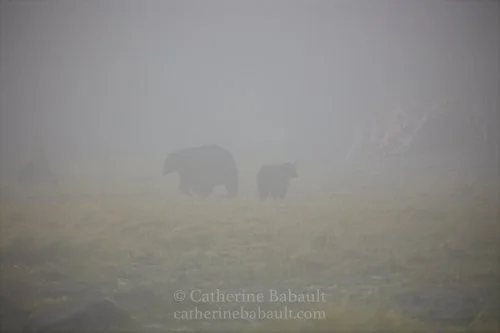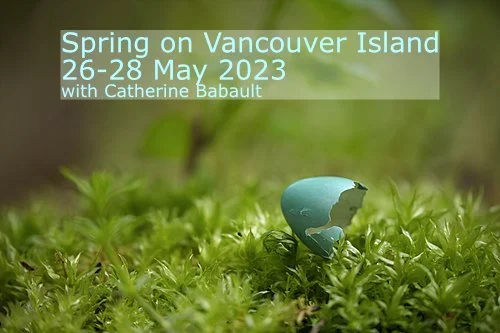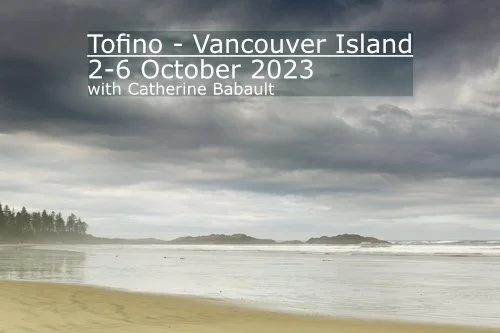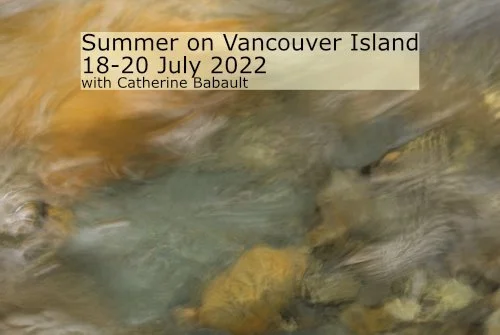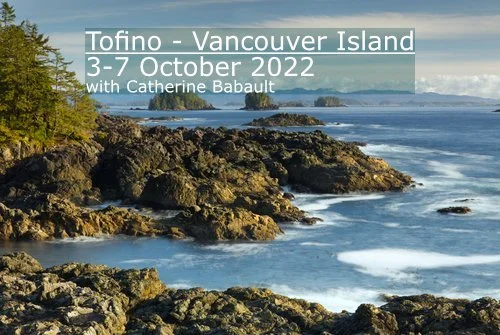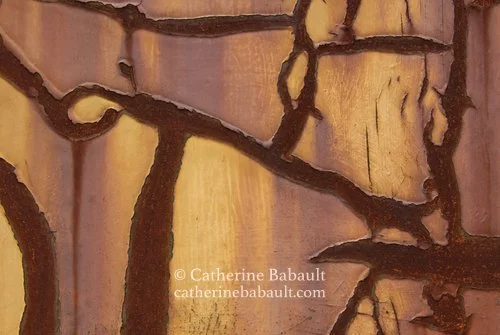Unique photo opportunities to capture black bears catching salmon, Roosevelt elk herds during the rutting period, and sea lions gatherings to feed along the coast.
Vancouver Island is a stopover on the Pacific Flyway whereas some birds choose to winter on the island such as trumpeter swan, long-tailed duck and surf scoter.
Lower light conditions are better for nature photography.
Fall is a display of vibrant colours in the rainforest while winter offers misty landscapes and waves crashing on the rugged shoreline during storms.
The shoulder season is a great time to enjoy the tranquility in the forest and take the time to create your best images. It is also cheaper to travel.
Interview on Global TV News with Jennifer Palma
On December 1st, 2024, I had the honour to talk with Jennifer Palma on Global TV News about my book Wild Vancouver Island. I am grateful for this opportunity to share my passion for nature and wildlife photography. To me being a wildlife photographer means learning as much as I can about each species that I have the privilege to photograph. In addition, it is essential for me to keep a safe distance from wildlife, respect their environment and avoid disturbing them.
Book Review: Wild Vancouver Island
I am thrilled to announce that my new photography book Wild Vancouver Island has received an outstanding review in the Vancouver Sun. Tom Sandborn wrote: ''She has clearly mastered the technical aspects of her art, and that mastery frees her to bear witness to the spirit of joy, discovery and delight that informs her engagement with the creatures and elements she portrays.'' Read more…
Wild Vancouver Island is the perfect gift for the photographer or nature lover in your life, or for yourself. You can order a copy here.
Wild Vancouver Island - Discount on Pre-orders
I’m thrilled to announce my new photography book Wild Vancouver Island. I have been working on this beautiful book for the last few months and I can’t wait to show it to you! Wild Vancouver Island is a celebration of the beautiful landscapes and extraordinary diversity of species that inhabit this region. As you may know, I have a fondness for bears. Last fall, I had the privilege of photographing coastal black bears up close during the salmon run and I selected my best shots for the book, which also features many other species such as sea otters, humpback whales, Roosevelt elk, and several birds and mammals.
Wild Vancouver Island is a book for gifting, to you or a loved-one, perhaps as a reminder of the beauty of nature and the importance of biodiversity.
Get a 10% discount on pre-orders. I sign each copy! Let me know if you’d like me to add a personal note. For those of you who live in the Comox Valley, enter COMOXVALLEYFS at checkout for a free delivery at your doorstep.
Design in Nature
Watch my new video about the elements of design in nature.
Shapes, colours, lines, textures and repetition of patterns help to create bold images that evoke an array of feelings. Video by Catherine Babault, nature photographer on Vancouver Island, British Columbia, Canada.
Who is Catherine Babault?
I was born and grew up in France before immigrating to Canada in my early twenties. I identify as a Canadian photographer not as a French photographer living in Canada.
I received my first camera when I was ten years old for a school trip to England. When I returned home, I had more pictures of horses in a field than London’s famous landmarks. I always loved nature and animals. At 20 years old, I decided to travel abroad for a few months before settling down and getting a real job. So I bought a backpack and a plane ticket Paris-Montreal. First time on a plane, first trip on my own. In Montreal, I stayed at a friend’s place I met a few months earlier in Paris. I spent three months in Canada and the US backpacking by myself from Montreal to San Diego, California, including a day trip to Tijuana, Mexico. I have been travelling solo ever since because I enjoyed the freedom experienced on my first solo trip.
Traveling solo as a young woman makes you reflect on who you are and what you want to do with your life. No family, friends or partner are there to distract you from your thoughts or to influence your decisions. When you are in a foreign country on your own as a woman, you also have to be aware of your environment and trust yourself: no matter the situation, you will find a solution. That trip across North America set the course for the rest of my life: I decided that I wanted to keep traveling, discover other cultures and see various landscapes and wildlife.
Since I immigrated to Canada a long long time ago, I lived in four provinces but British Columbia is the place where I feel the most at home, especially Vancouver Island. The people, various cultures, landscapes and wildlife are a great source of inspiration and satisfaction. Over the past decades, I had a real job but it was not as satisfying as spending time in nature and photographing wildlife. So when I lost my job in 2018, I decided to follow my dream and become a full-time nature and wildlife photographer. One of my motto is to not have regrets when my time comes. Whether I fail or succeed in my endeavour as a professional nature photographer, at least I would have tried and put all my time and energy into it.
It has now been five years since I started my small business as a nature photographer. I have learned a lot about running a business and also the world of professional photography. The pandemic after only two years in business has definitely slowed things down and had a substantial financial impact. I also quickly realized that the most recognized and celebrated nature and wildlife photographers are men. They dominate the industry, which is already very competitive. Despite those challenges, I love my new real job.
I love learning about wildlife, planning a trip, preparing my gear for an expedition, walking in nature on my own, tracking wildlife, listening to animals in the forest, and the feeling that nature is bigger than me, than us. And when I finally meet the animal I spent all that time researching in the office and traveling and hiking and waiting for in all kinds of weather conditions, and there it is, right in front of me, what an amazing feeling!
One of my most memorable moments as a wildlife photographer was during the salmon run. It took me years to find that perfect spot for bear photography. I was on my own, far from the nearest town or human. Thick fog covered the sea, shoreline and forest. Black bears appeared and disappeared through the dense fog as they looked for a prime spot to get a salmon going up the river. They sat by the water glancing at me once in a while. I kept a respectful distance. All was quiet except for the water cascading down the rocky shoreline. I patiently waited for bears to get a salmon. They then slowly walked back to the forest to eat their meal in peace or feed their cubs. On that day, I felt privileged to be in the presence of such an amazing animal.
Following our dreams can be challenging but it has its rewards, and when my time comes, I won’t have any regrets.
Interview on Shaw TV Spotlight
I was recently invited by Shaw TV for their program Spotlight to talk about my work as a nature and wildlife photographer. I also spoke about my keen interest for the Vancouver Island marmot, an endangered species which is endemic to the Island, and my time spent photographing them in the alpine meadows somewhere on Vancouver Island. That work in the field resulted in a photo book to raise awareness about the marmot’s plight and the recovery efforts undertaken to save it from extinction.
I invite you to watch the interview.
Book Review in Vancouver Sun
My photo book Vancouver Island Marmot, The World’s Rarest Marmot received an incredible book review in this weekend edition of the Vancouver Sun. It is ‘‘highly recommended’’!
I am very grateful to Tom Sandborn for his kind words. Read his review.
Interviewed for Shaw TV Spotlight
I recently spoke with Gordon Darby, producer, Shaw TV Spotlight. We meet on a windy and cold day at a park in Courtenay to talk about my passion for wildlife photography, and particularly for the Vancouver Island marmot. You can watch the interview here.
J’ai récemment parlé avec Gordon Darby, producteur, Shaw TV Spotlight. Nous nous sommes rencontrés lors d’une journée venteuse et froide à un parc à Courtenay pour parler de ma passion pour la photographie animalière, et en particulier pour la marmotte de l’île de Vancouver. Vous pouvez voir l’entrevue en anglais ici.
Book a Nature Photography Workshop on Vancouver Island, British Columbia
A new year means new resolutions like traveling more or exploring new places, camera in hand.
On your visit to Vancouver Island, British Columbia, sign up for a nature photography workshop with a local photographer: me. Explore the rugged coastline and the temperate rainforest, capture unique species with your camera, and return home with compelling photos.
2023 Photo Workshops and New Videos
I remember the cultural revolution when the first music videos appeared on the television in the 1980s. Today, everyone posts videos on TikTok, YouTube, etc. That's why I just produced and posted my first two videos on YouTube, which you can watch here. You will discover in particular rare photos of the Vancouver Island marmot, an endangered species.
Following an increase in requests from photographers in the United States and Europe, I have just added several photo workshops for 2023. There are still spaces available for the 2022 workshops. However the maximum number of participants per workshop is five, so don't wait too long to sign up.
''I took her workshop and it was very informative at the same time enjoyable. we discovered amazing part of island and shoot lots of pictures. Catherine is very professional and friendly. She opened up my eyes in different perspective of photography. She is also very patient and explain everything in detail. By end of our workshop I am more comfortable with camera settings, composition. long exposure and work on tripod 😃. I highly recommend her workshop for anyone who wants step in nature, landscape and wildlife photography.'' Mehrdad S.
I hope you take advantage of the long summer days to explore nature and photograph cute animals like this baby black-tailed deer that I briefly encountered earlier this week on Vancouver Island.
New workshops for this summer!
Summer is an ideal time to reconnect with nature and hone your skills as a nature photographer. Join me for a unique photo workshop in beautiful Strathcona Park, on Vancouver Island, British Columbia, Canada.
I have added three new workshops on weekends for your convenience:
Limited to 5 participants. Sign up today!
Tel que vu à CBC Radio-Canada
Réalisation et montage : Pierre Beaudoin, caméra : Alexandre Lamic, CBC Radio-Canada
Photo : Alexandre Lamic, Radio-Canada
L’automne dernier, j’ai eu le plaisir d’être filmée par CBC Radio-Canada sur le terrain sur l’Île de Vancouver. Au cours de l’entrevue, je parle d’espèces menacées dans la région et d’espèces à risque d’extinction comme la marmotte de l’Île de Vancouver. Je mentionne aussi l’importance de l’éthique dans la photographie de nature pour préserver le monde naturel; nous pouvons tous faire notre part en gardant une distance sécuritaire avec les animaux, en évitant de les déranger dans leur routine et en n’interférant pas avec leur habitat.
Je vous invite à regarder la vidéo ici.
As seen on CBC Radio Canada...
Production and montage: Pierre Beaudoin, camera: Alexandre Lamic, CBC Radio-Canada.
Photo credit: Alexandre Lamic, Radio-Canada
Last autumn, I had the pleasure of being filmed by CBC Radio-Canada in the field on Vancouver Island. During the interview, I talk about species of special concern in the region and endangered species like the Vancouver Island marmot. I also mention the importance of ethic in nature photography to preserve the natural world; we can all do our part by keeping a safe distance from wildlife, avoiding disturbing their routines and not interfering with their habitat.
I invite you to watch the video here.
Abstract Images, Photo Tip and Spring Workshop
Hello Yellow - Abstract image
Travelling is part of my life so, after more than two years on Vancouver Island, it was time to get out.
I always plan my adventures carefully: places to visit, subjects to photograph, routes, etc., which is why I travelled to Astoria, Oregon. I wanted to photograph an old rusty wagon, abandoned boats and buildings marked by the passage of time. My preparation and the time spent on site for this project gave results beyond my expectations. You can order prints here.
As I often mention during my workshops, it is important to take your time in the field: find your subject, think about your composition, adjust your camera properly according to the expected results (framing, depth of field, shutter speed, etc.) You will achieve better results than taking lots of photos hoping that one will be good enough and then trying to correct its flaws in post-processing.
This spring, reconnect with nature and sign up for a photo adventure for yourself or with a loved one, on Vancouver Island, British Columbia! Spring is an ideal time to travel: it’s an amazing palette of colours, the snow melt swells streams to form beautiful cascades, and animals are busy caring for their offsprings: very photogenic subjects. I invite you to register for my workshop from May 27 to 29, places are limited to 5 people.
Photos abstraites, truc en photo et atelier du printemps
Loop - Abstract Photography
Les voyages font partie de ma vie alors, après plus de deux ans sur place, il était temps de sortir de l’Île de Vancouver.
Je prépare toujours soigneusement mes aventures : lieux à visiter, sujets à photographier, trajets, etc., c’est pourquoi je me suis rendue à Astoria, en Oregon. Je souhaitais photographier un vieux wagon rouillé, des bateaux abandonnés et des bâtiments marqués par le passage du temps. Ma préparation et le temps consacré sur place pour ce projet ont donné des résultats au-delà de mes attentes. Vous pouvez en commander des tirages.
Comme je mentionne souvent au cours de mes ateliers, il est important de prendre son temps sur le terrain : trouver son sujet, penser à sa composition, bien réglé son appareil en fonction des résultats escomptés (cadrage, profondeur de champs, vitesse d’obturation, etc.) Cela permet d’obtenir de meilleurs résultats que de prendre plein de photos dans l’espoir que l’une d’entre elles sera assez bonne et ensuite tenter de corriger ses défauts en post-traitement.
Ce printemps, reconnectez-vous avec la nature et inscrivez-vous seul(e) ou avec un proche à une excursion photo sur l’Île de Vancouver, en Colombie-Britannique ! Le printemps est un temps idéal pour voyager : c’est une incroyable palette de couleurs, la fonte des neiges fait gonfler les cascades et les animaux sont occupés avec leurs petits : des sujets très photogéniques. Je vous invite à vous inscrire à mon atelier du 27 au 29 mai, les places sont limitées à 5 personnes.
Spot Distracting Elements
When I am on a photo excursion in the forest, the red-legged frog tends to appear when I least expect it. Their colour is an excellent form of camouflage. Often, it is their leap at my approach that catches my eye. During any chance encounter with an animal, it is sometimes difficult to predict their reaction: will they run away or stay put? That’s why my first reaction is to stop and anticipate their intentions. Then I started moving cautiously to avoid frightening them while I think about my composition and my distance from the animal.
I determine where the light is coming from and if there is a backlight. I identify elements such as a branch in front of the frog or any other shape or object that might distract the attention of the person looking at the photo. I move slowly and, once in position, I carefully deploy my tripod. A stressed frog will puff up its abdomen to deter predators. I therefore keep an eye on my subject to assess their level of comfort; if I notice that they are stressed, I leave even though I have not got a shot. The animal wellbeing is more important to me than my portfolio. Once the camera is mounted on the tripod, I adjust the settings and frame based on the intended result before releasing the shutter. Then I check the composition and histogram on the camera screen.
Because it is a chance encounter with a wild animal, everything happens very quickly and yet quietly so as not to stress it. Also I don’t overstay to avoid disturbing the animal in its routine.




































